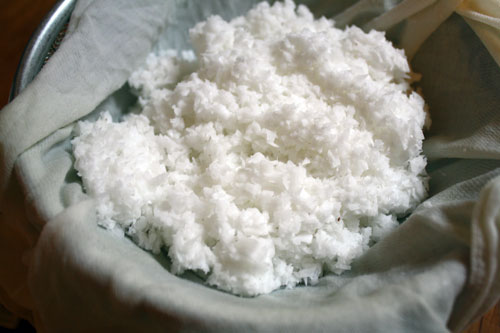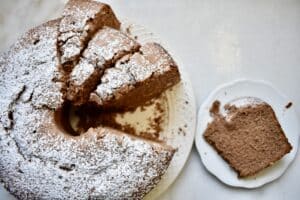Friends, I have been on a quest. I’m not searching for buried treasure or hidden scrolls or even spiritual enlightenment, though what I’ve been seeking has been as elusive as all of the above.
I have been searching for a better coconut milk.
Coconut milk has long been a part of my diet, and it became an even larger part of my diet about 3 years ago when I began eating allergen-free foods. And then I found out how good it is for your tummy and I began to eat even more.
But the dilemma of coconut milk did always kinda bother me. I used the stuff in the refrigerated carton as my milk substitute, and I used the stuff in the cans for soup and curry, but honestly both products always nagged at me. They are both full of gums and stabilizers and preservatives, and the canned stuff has chemicals in it from the can-liners. I never knew there were other options, so I just kept on using them.
But when I started the GAPS Diet a few months ago, I knew that both of these products were completely unacceptable for GAPS (because of the before-mentioned reasons), and I had to find something else. It wasn’t until recently that I had the energy to go looking, and I found some great alternatives. And do you know what? I’m going to share them with you, just to save you the trouble.
1. A real coconut
I began my search at a logical place, with a real coconut. I found tutorials on several blogs (who shall be unnamed). They all swore it was a cinch, that it takes all of 30 minutes to process a fresh coconut into a quart of coconut milk. And I believed them. 2 1/2 hours, one very deep puncture wound, and many curses later I finally had my coconut milk.
I’ll tell you how to do it, but I don’t recommend it. If you’re going to give it a try, approach it like you would shelling peas, or shucking corn. Gather the family and sit on the front porch one evening and turn it into entertainment. If you approach it like I did (a straightforward task to be addressed quickly and efficiently) you’re going to be disappointed.
- Begin with 2 fresh coconuts. Why two? Because if you’re going to do one, you might as well do two. Pick a good coconut by shaking it close to your ear. If you hear a sloshing inside, it still has the coconut water in it and is nice and fresh.
- Puncture the “eyes” on the top of the coconut. See the three little dents that look like a bowling ball? These spots are relatively soft. Some folks will tell you to use a knife to do this. Please don’t. Go to the garage and get your husband’s electric drill, or at least a screwdriver and a hammer. You will keep all of your fingers this way, and your knives will stay sharp.
- Drain the coconut water through the holes into a bowl.
- Wrap your coconuts in a towel, and find a hammer and a solid surface (the driveway works quite well here). Pound the coconuts until they split open. And then pound the coconut pieces until they are in smaller pieces. The smaller the pieces, the easier it will be to get the meat out (the pieces in the photo are way too big, as I soon found out)
- Using a flathead screwdriver, and possibly a small hammer, pry the coconut meat (the white part) out of the coconut shell (the hard brown part). A thin, brown skin will remain. We’ll deal with this later. Now, some blogs will tell you to use a knife for this process, but those blogs will not pay your urgent care bill when said knife goes into your thumb all the way to the bone. Trust me on this one. Thankfully, I have a darling Sweetie Pie husband who, when I walk into the room holding a knife, a hammer, and a bleeding finger, says, “Do you need some help?”
- Once you’ve gotten the meat out of the husk, use a vegetable peeler or a sharp knife (there’s that knife again) to peel off the thin, brown membrane. By this time it’s late and you’re tired. Turn on some trashy reality TV show to entertain you while you finish the job.
- Put all of this meat into your blender or food processor, along with the coconut water, and 4 cups of hot water. I started off with the blender, but my chunks were too big and the blades kept getting stuck. So I poured it into the food processor, and it leaked all over my counter because the liquid was too high. So I processed it just enough to make the pieces smaller, then put it all back into the blender, added some more water and then finished the job. Please save yourself the trouble and just make your chunks smaller to begin with.
- Line a colander with cheese cloth, muslin, or some other fine straining device. I always use a clean burp-rag. Set the colander over a bowl. Pour what’s in the blender into the colander and let it strain. Gently squeeze the fabric to get out all of the liquid. Notice I said squeeze gently. Because if you get greedy and squeeze too hard, then your rag will start ripping and the meat will start falling into the milk and you will feel like sitting on the kitchen floor and crying. Not that I experienced any of that.
- Pour the liquid into a jar. This is your coconut milk. The solids may be spread onto a baking sheet and dehydrated on a very low temperature in the oven until they are dry. Use like regular dried coconut.
Now, I won’t lie. I took a sip of this coconut milk and it was incredible. But even the taste of it didn’t make the trouble of making it worth it. So I went in search of other options. If you want to keep all of your fingers and your sanity, here are my other recommendations.
2. Concentrated coconut cream
Until recently, I had no idea that this product existed. How could I have lived without it for so long??
Concentrated coconut cream, sometimes called coconut butter, is the coconut meat and milk all ground together and concentrated. It’s basically what I took out of the blender, only chopped much finer and concentrated. Because it still has the meat in it, it’s not perfectly smooth. You can eat it as is like a nut-butter, or you can dilute it with water (one part cream to two parts water) to make coconut milk.
Different brands have different levels of grittiness. When I went shopping for it, I found three different products in three different places. And they all have very different flavors. You’ll have to do some trials to find the one that you love the best, but here are the ones I tried, and how I liked them.
The product on the left was the smoothest and had the least pronounced coconut flavor. It tasted a bit chemically to me, and I wondered if it had been bleached somehow because it was also the whitest. This product was, naturally, the least expensive. I don’t plan to buy it again.
The product in the middle was mostly smooth, had a mild coconut flavor and made the best coconut milk of the three. It has been heat processed, so has lost some of the nutrition of a raw coconut. I like this one for making milk, and also for baking GAPS-friendly treats at high temperatures.
The product on the right was incredibly rich and coconutty. It is thick, like a nut-butter, and while the other two required me to heat them a bit and mix them up because the oil had separated, this one did not. I’m smitten with this coconut butter. I eat it straight out of the jar as a snack. If I was eating anything to spread it on, I’d use it as a spread. Since this one is raw, I don’t use it for baking at high temps, but I do use it to make raw treats……like Cocoa-nut Truffles (come back next week for a recipe!) Surprisingly, I didn’t prefer the milk that this one made.
And if you truly are determined for fresh coconut milk, but you want to keep all your digits safe, I recommend…
3. A pre-husked raw coconut
…which I found at the local Asian grocers for all of $2.50. Simply chop it up and blend it with some water. Strain it and you have your coconut milk without all the hassle. Why didn’t I do this the first time??
Personally, I’ll be using the coconut cream concentrate on a regular basis to make my coconut milk. I find the flavor to be good, and the convenience can’t be beat.
Have you tried making coconut milk? Do you have a favorite method beyond opening a can?
















